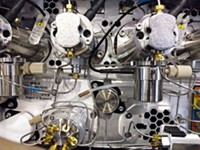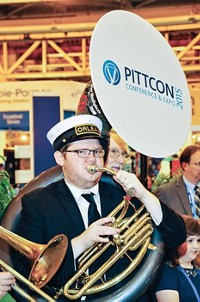Advertisement
Grab your lab coat. Let's get started
Welcome!
Welcome!
Create an account below to get 6 C&EN articles per month, receive newsletters and more - all free.
It seems this is your first time logging in online. Please enter the following information to continue.
As an ACS member you automatically get access to this site. All we need is few more details to create your reading experience.
Not you? Sign in with a different account.
Not you? Sign in with a different account.
ERROR 1
ERROR 1
ERROR 2
ERROR 2
ERROR 2
ERROR 2
ERROR 2
Password and Confirm password must match.
If you have an ACS member number, please enter it here so we can link this account to your membership. (optional)
ERROR 2
ACS values your privacy. By submitting your information, you are gaining access to C&EN and subscribing to our weekly newsletter. We use the information you provide to make your reading experience better, and we will never sell your data to third party members.
Business
Instrument Makers Set Confident Tone
Brighter economic prospects set instrument industry on a path to stronger sales in 2014
by Marc S. Reisch
March 31, 2014
| A version of this story appeared in
Volume 92, Issue 13

Science mavens come to the Pittsburgh Conference on Analytical Chemistry & Applied Spectroscopy—Pittcon, for short—looking for new technology and new ways to solve analytical problems. Among the new product introductions at the forum, held earlier this month in Chicago, were microfluidic devices, productivity tools, benchtop nuclear magnetic resonance instruments, and semiconductor-controlled technologies.
COVER STORY
Instrument Makers Set Confident Tone
Frigid weather conditions and flight cancellations interrupted visitors’ travel plans this year, and so just 16,225 people made it to the Windy City for the annual instrumentation confab. More than 18,000 people attended the gathering last year in Philadelphia.
But attendance at Pittcon doesn’t determine the economic fortunes of the manufacturers that exhibit there. And instrument company executives in Chicago were more bullish about their business prospects than they were last year at this time because of improving economies in the U.S. and Europe.
In the U.S. as well as overseas, pent-up demand for health sciences instrumentation means spending in the segment is likely to improve along with economic conditions, according to Arthur G. Caputo, executive vice president of instrument manufacturer Waters Corp.
Waters used Pittcon as a venue to introduce a microfluidic separation device, the ionKey/MS, which integrates with the firm’s Acquity M-Class chromatography system and Xevo TQ-S mass spectrometer. The self-calibrating device, about the size of a smartphone, simplifies compound detection and improves sensitivity compared with existing tools, Waters said. Potential applications include bioanalysis, pharmacokinetic studies, and food safety analysis.
Waters’ new product falls nicely into what attendee Isaac Ro, an instrumentation analyst for investment bank Goldman Sachs, described as a trend among instrument makers to pitch new products “that combine core technologies and software into simplified workflows.”
Like Caputo, Rainer Blair, president of mass spectrometry specialist AB Sciex, anticipates a better 2014. Europe, which was slow last year, has been picking up, he said, although the political uncertainties surrounding Ukraine could hurt instrument sales in Eastern Europe. Developing markets are getting stronger this year, Blair observed, with the exception of China, where the government is holding back on executing funding commitments.
“The economic environment is still stressful for many customers,” acknowledged Jakob Gudbrand, chromatography vice president for Thermo Fisher Scientific , “but we still see the need for productivity tools. ‘Faster’ and ‘better’ are still important buzzwords.” Among those new tools at Pittcon was an update to the firm’s Chromeleon software to expand the number of instruments it controls. Thermo Fisher also showcased a vial label system that can reduce errors caused by handwritten identifications.
A good sign in the U.S., Gudbrand said, is the end to the government sequestration—mandated across-the-board federal budget cuts—that caused a slowdown in instrument spending in 2013. “We see no such headwinds in 2014,” he added.
Christopher P. Gaylor, vice president of Shimadzu Scientific Instruments, is also happy that the government sequestration program is over for now, but he is still cautious about the overall U.S. market for instruments this year.
“We’re getting calls for quotes now that we weren’t getting last year,” he said, referring to government-funded researchers. However, concerns about taxes and regulations are keeping industrial customers cautious about new instrument purchases.
At Pittcon, evidence of the long ongoing consolidation trend among instrument makers continued. Thermo Fisher is now among the largest instrument makers, having completed its $13.6 billion acquisition of Life Technologies in February. And the firm just bought Switzerland-based Prionics, an animal disease diagnostics maker, for an undisclosed sum.
Other firms are growing on a smaller scale. In September 2013, for example, Malvern Instruments bought England-based nanoparticle-tracking instrument maker NanoSight for $24 million. As a result, Malvern is expecting more growth, especially in the biopharmaceutical market, President Brian W. Dutko said.
Malvern also partnered recently with San Ramon, Calif.-based RheoSense to offer the latter’s semiconductor-based rheometer to customers in markets such as coatings, beverages, and lubricants. Known as the m-VROCi, the rheometer uses microelectromechanical system (MEMS) sensor chips and microfluidics to analyze samples.
An unusual exhibitor at Pittcon was Texas Instruments, which showed its digital light-processing (DLP) MEMS chip optimized for near-infrared light. The semiconductor producer was not at Pittcon to show off a new instrument so much as to demonstrate a technology that instrument makers could adapt for their next-generation spectrometers.
“The DLP chip consists of 1 million micromirrors on an integrated circuit optimized to steer near-IR light for spectroscopy,” explained Gina Park, a Texas Instruments line manager. Similar in design to the DLP chips now used in office and school video projectors, the chip contains micromirrors that are efficient at transmitting light in the 800- to 2,500-nm wavelength range instead of the 400- to 700-nm visible range, she said.
The chip can be programmed to produce set patterns and to control wavelength ranges. “When paired with a single-element detector, the chip replaces expensive linear detector arrays to create high-performance affordable spectrometers for use in the field or on manufacturing lines,” Park said.
Also notable at Pittcon were a number of benchtop NMR detectors, priced below $100,000, based on relatively small permanent magnets. Thermo Fisher, for instance, showcased a new 80-MHz NMR instrument intended for the research market.
Magritek, a New Zealand-based start-up, offered a benchtop NMR as well. Andrew Coy, the firm’s chief executive officer, called benchtop NMR a “whole new product category” because of the convenience it provides in obtaining molecular information. The firm’s latest introduction is the Spinsolve Carbon, an NMR system intended for pharmaceutical and small-molecule research. Others that recently introduced benchtop NMR instruments are Bruker, Oxford Instruments, and Nanalysis.
Even with all the neat new products, AB Sciex’s Blair cautioned, 2014 could turn out to be as slow as 2013. But with better economic conditions expected in the U.S. and Europe, most instrument makers are counting on a sustained pickup in sales this year.




Join the conversation
Contact the reporter
Submit a Letter to the Editor for publication
Engage with us on Twitter